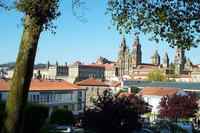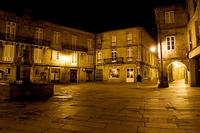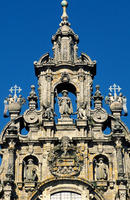You are in: Europe -> Spain -> Santiago de Composte... , and traditional search or Image Gallery will yield results of this site only
Santiago de Compostela (Old Town)
| Site number: | 347 |
|
| Type of site: | Cultural | |
| Date: | 10th century | |
| Date of Inscription: | 1985 | |
| Location: | Europe, Spain, Province of A Coruña, Autonomous Community of Galicia | |
Up to 75 images are shown here. Click on each for more details or on Image Gallery for more images.
Six official UN languages:
Arabic,
Chinese,
English,
French,
Russian,
Spanish
Other languages: Alemannic German, Bulgarian, Catalan, Danish, Dutch, Esperanto, Finnish, Galician, German, Hebrew, Hungarian, Italian, Japanese, Latin, Limburgish, Luxembourgish, Norwegian-bokmål, Norwegian-nynorsk, Occitan, Polish, Portuguese, Romanian, Serbian, Slovak, Swedish, Turkish, Welsh
Other languages: Alemannic German, Bulgarian, Catalan, Danish, Dutch, Esperanto, Finnish, Galician, German, Hebrew, Hungarian, Italian, Japanese, Latin, Limburgish, Luxembourgish, Norwegian-bokmål, Norwegian-nynorsk, Occitan, Polish, Portuguese, Romanian, Serbian, Slovak, Swedish, Turkish, Welsh
| Description: | Santiago de Compostela is a renowned pilgrimage site in north-west Spain, which developed into a symbol for the Spanish Christians' struggle against Islam. At the end of the 10th century it was destroyed by the Muslims, and the following century witnessed a complete rebuilding of the city. Endowed withs Romanesque, Gothic and Baroque buildings, the Old Town of Santiago is among the world's most stunning urban landscapes. The site’s oldest tombstones are assembled surrounding the tomb of St James and the cathedral, which holds the incredible Pórtico de la Gloria. --WHMNet paraphrase from the description at WHC Site, where additional information is available. | |
| Santiago de Compostela (also Saint James of Compostela) is the capital of the autonomous community of Galicia. Located in the northwest region of Spain in the Province of A Coruña, it was the "European City of Culture" for the year 2000. The city's cathedral is the destination of the important medieval pilgrimage route, the Way of St James (in Spanish the Camino de Santiago). The cathedral borders the main Plaza of the old and well-preserved city. Across the square is the Palacio de Raxoi (Raxoi's Palace), the town hall and seat of the Galician Xunta, and on the right from the cathedral steps is the Hostal dos Reis Católicos, founded in 1492 by the Catholic Monarchs, Isabella of Castille and Ferdinand of Aragon, as a pilgrim's hospice (now a parador). Santiago de Compostela was founded by Suebi people at the end of the 4th century or the beginning of the 5th century. The legend that St James found his way to the Iberian peninsula, and had preached there is one of a number of early traditions concerning the missionary activities and final resting places of the apostles of Jesus. Although the 1884 Bull of Pope Leo XIII Omnipotens Deus accepted the authenticity of the relics at Compostela, the Vatican remains uncommitted as to whether the relics are those of Saint James the Great, while continuing to promote the more general benefits of pilgrimage to the site. According to a tradition that cannot be traced before the 12th century, the relics were said to have been discovered in 835 by Theodomir, bishop of Iria Flavia in the far northwest of the principality of Asturias. Theodomir was guided to the spot by a star, the legend affirmed, drawing upon a familiar myth-element, hence "Compostela" was given an etymology as a corruption of Campus Stellae, "Plain of Stars." As suggested already, it is probably impossible to know whose bones were actually found, and precisely when and how. Perhaps it does not matter. What the history of the pilgrimage requires, but what the meager sources fail to reveal, is how the local Galician cult associated with the saint was transformed into an international cult drawing pilgrims from distant parts of the world. The 1000 year old pilgrimage to the shrine of St James in the Cathedral of Santiago de Compostela is known in English as the Way of St. James and in Spanish as the Camino de Santiago. Over 100,000 pilgrims travel to the city each year from points all over Europe, and other parts of the world. --Wikipedia. Text is available under the Creative Commons Attribution-ShareAlike License. | ||
| Source: | http://whc.unesco.org/en/list/347 | |
| Source2: | http://www.google.com/intl/en/landing/unesco/ | |
| Reference: | 1. UNESCO World Heritage Center, Site Page. | |















